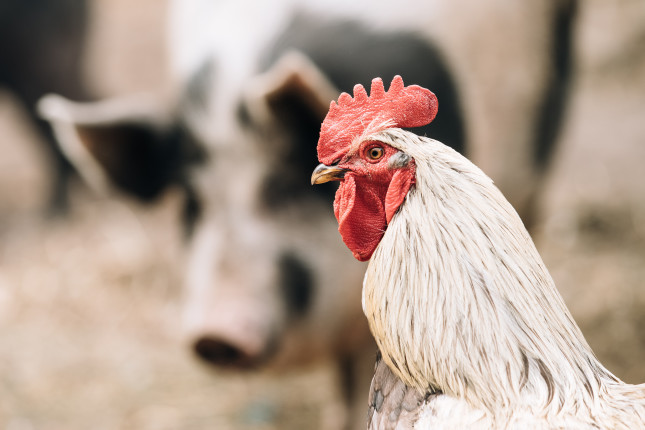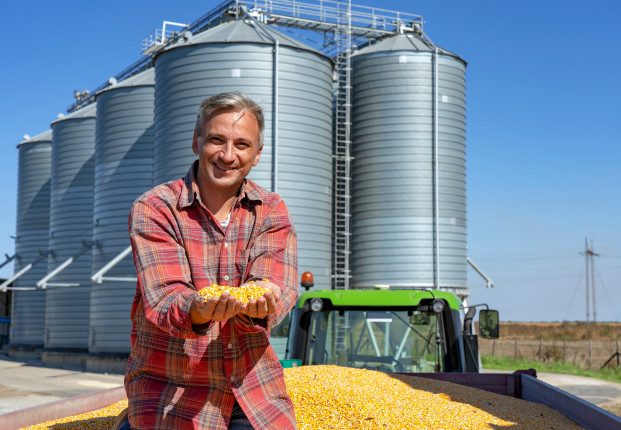-
Greening Eggs and Ham: Animal Feed and GHG Emissions in the United States and China
June 1, 2023 By Karen Mancl“Save your kitchen scraps to feed the hens,” urged a poster for the victory gardens created on the home front in the Second World War. Feeding food scraps to backyard chickens and pigs turned this waste into a delicious source of human food. Pigs were especially prized in this effort as they would eat what most other animals considered inedible.
Times have changed in both the United States and China. Chinese farms are the world’s number one chicken producers and boast half the world’s pig population. Today, most U.S. farms feed grain to pigs and chickens. And China recently halted its widespread use of food waste to supply chicken and pigs after an outbreak of disease in 2019.
Perhaps going back to past methods might create a greener future. Today, a third of food grown globally is wasted, and as it decomposes it emits methane — a super climate pollutant that is 80 times more potent than carbon dioxide. Annual methane emissions from food waste are equivalent to total road transport greenhouse gas emissions. Already worldwide, 30 percent of animal feed is food waste, an oft unrecognized form of climate action.
The United States and China are the biggest contributors of these methane emissions. Yet they may be ready to take action. Both nations agreed in their 2021 Glasgow Climate Declaration to cooperate on green and climate resilient agriculture. Moving animal feed onto the climate agenda is one way both countries could work together. The U.S. and China might find better ways to reuse food waste as animal feed and also reduce reliance on imported animal feed, creating a win-win climate solution.
How Disease Changed the Equation on Food Waste as Animal Feed
The U.S. changed course decades ago. But until 2019, the collection and transport of food waste from restaurants, hotels, and cafeterias in China was a booming industry to supply China’s chicken and pig farms.
Food waste practices changed in China, after an outbreak of African Swine Fever that in one year killed more than 120 million pigs — a quarter of China’s total population. In response, China banned feeding food waste to pigs, because the virus was found in food waste coming from the meat of infected pigs.
Public health was also what spurred change in the U.S. a decade earlier. In 2009, the U.S. Congress passed the Swine Health Protection Act to protect swineherds from disease. While the U.S. government does still permit food waste as feed, farmers must be licensed to collect it from restaurants, school cafeterias and food processing plants. They also must cook any pathogens from food waste after its collection. Even with these protections in place, 23 states still prohibit the practice entirely.

Grain as a Replacement Brings a High Carbon Cost
Instead of using food waste, Chinese farmers have switched to buying corn and soybean meal to feed pigs and chickens. This soy/grain diet is balanced with just the right amount of carbohydrates, fat, and most importantly, protein.
Countryside landscapes in both the U.S. and China are dotted with large metal bins where grain is dried and stored in the fall for sale, export, and to feed livestock year-round. To prevent toxic mold from growing, farmers must store this grain at just the right moisture content.
Of all the energy it takes to produce corn grain, 33 percent is used to dry it for storage. The process requires fans to blow warm air heated by propane or natural gas through the grain. Yet there is also a climate cost to this activity.
In an interview, Dirk Maier, Agricultural Engineering Professor at Iowa State University, observed that for every metric ton of corn handled, dried, and stored, 58.3 kg of carbon dioxide equivalent (CO2e) is released into the atmosphere. The fact that the United States alone stores about 6 billion tons of grain makes the CO2 emitted from grain drying a significant and unaddressed agricultural source of greenhouse gas emission.
The situation in China is similar. Liu Xiangdong, a Professor in the College of Engineering at the China Agricultural University, found that 83 percent of grain is dried using coal, so this practice is a large emitter of greenhouse gas as well. Grain drying in China emits just under 6 million tons of carbon dioxide annually, making it the most energy intensive and polluting process in the grain industry.
Moving Animal Feed onto the Climate Agenda
Even as food waste receded in agricultural usage, efforts were being made to refine and restore it. In 2011, the U.S. Environmental Protection Agency launched its Food Recovery Challenge to capture food scraps. In the first year, 77 grocery stores, universities, and sports and entertainment venues took up the challenge. One of the biggest success stories was the MGM resorts in Las Vegas, which took a gamble and started collecting food waste from its restaurants and dining rooms in 2012. In 2017, 1,904 tons of food waste from the Bellagio Hotel were fed to 3,000 pigs on a farm north of the city.
Claudia Fabiano, an Environmental Protection Specialist in the EPA’s Office of Resource Conservation and Recovery, described how feeding food waste to animals is considered highly circular usage – since it maintains the original intent for food, which is to nourish people.
Canada is taking on leadership in reducing the climate footprint of grain drying. Its government is offering sticks — a new carbon tax on fuel for grain drying increases grain production costs $20 USD per hectare — as well as carrots. These incentives have taken the form of a $50 million Agricultural Clean Technology Program that Canada launched in 2021 as a part of its 2030 Emissions Reduction Plan. This program supports farmers as they upgrade old propane dryers to a new carbon-neutral system.
This tack is also being taken in the United States, where farmers are encouraged to replace old, polluting grain dryers with new, efficient equipment through the Farm Bill Environmental Quality Incentive Program (EQIP). Financial assistance is made available after farmers conduct an energy audit and develop an Agricultural Energy Management Plan. Additional cost-share funds also are now available through the Inflation Reduction Act Rural Energy Assistance Program. Farms and rural businesses can use the funds to shift grain drying to renewable energy systems.
China’s animal feed sector is still reacting to world trade policies and disease outbreaks, and food waste is not yet being considered as a way to reduce greenhouse gas emissions. Following the devastating impact of African Swine Fever, livestock operations are being modernized and intensified to increase efficiency and biosecurity. Chinese researchers are just starting to explore the impact of these shifts and government policies on food waste from rural households where scraps that once fed animals are now going to landfills and increasing reliance on imported grain and synthetic feed additives.
Greenhouse gas emissions from the animal feed sector are unexpectedly impacted by a wide range of international policies. Collaboration on finding safe ways to feed livestock food waste and developing alternative energy grain drying systems would help both China and the United States find win-win solutions to produce greener eggs and ham.
Karen Mancl is a Professor of Food, Agricultural and Biological Engineering at The Ohio State University and is the Director of the OSU Soil Environment Technology Learning Lab. She holds a PhD in Water Resources from Iowa State University, an MA in East Asian Studies and an MA in Public Policy from Ohio State University
Sources: Alberta Wheat and Barley, Austintexas.gov, Biocycle, China Dialogue, Dim Sums, FAO, Feed Additive, Food Policy, Foods Unfolded, Georgetown Journal of International Affairs, Global Times, Government of Canada, Grain Elevator and Processing Society, Harvard University Law, Land, NC State Extension, Poultry Producer, Observatory of Economic Complexity, Our World in Data, Reuters, The Pig Site, The Western Producer, University of New Hampshire, USDA, USEPA, WWF
Photo credit: Close up of white chicken rooster hen on pig snout background in rustic farmyard, courtesy of Grisha Bruev/shutterstock.com.
 A Publication of the Stimson Center.
A Publication of the Stimson Center.





